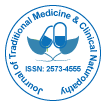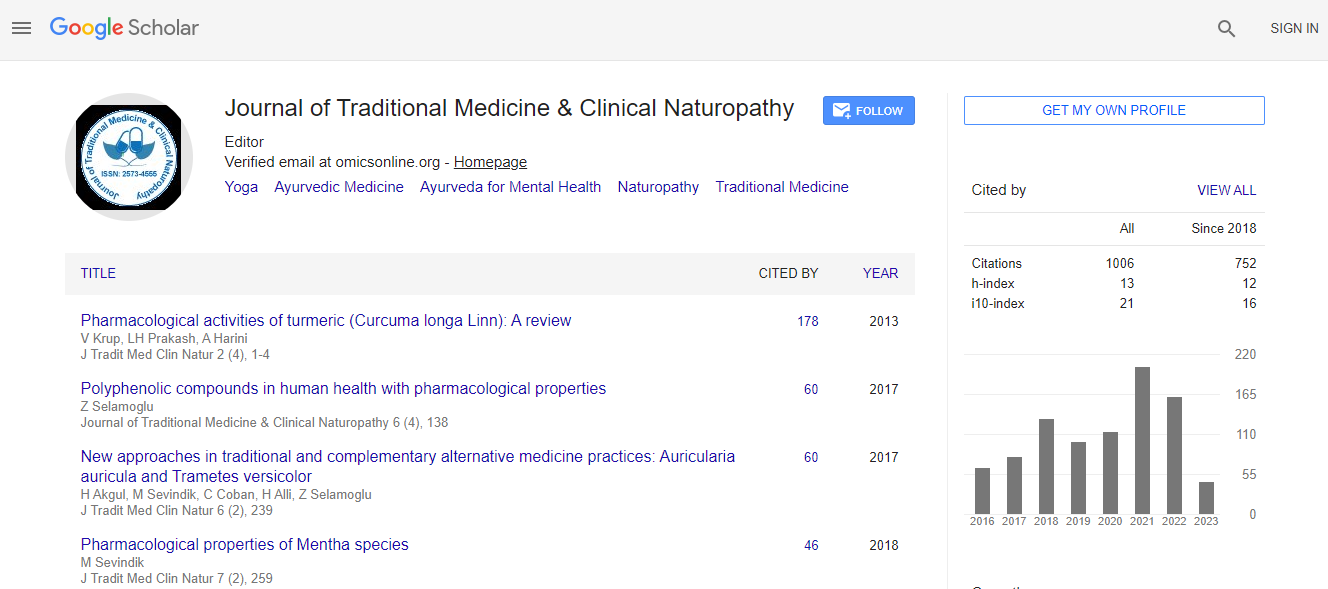Our Group organises 3000+ Global Conferenceseries Events every year across USA, Europe & Asia with support from 1000 more scientific Societies and Publishes 700+ Open Access Journals which contains over 50000 eminent personalities, reputed scientists as editorial board members.
Open Access Journals gaining more Readers and Citations
700 Journals and 15,000,000 Readers Each Journal is getting 25,000+ Readers
Google Scholar citation report
Citations : 1504
Journal of Traditional Medicine & Clinical Naturopathy peer review process verified at publons
Indexed In
- CAS Source Index (CASSI)
- Google Scholar
- Sherpa Romeo
- Open J Gate
- Genamics JournalSeek
- RefSeek
- Directory of Research Journal Indexing (DRJI)
- Hamdard University
- EBSCO A-Z
- Publons
- Geneva Foundation for Medical Education and Research
- Euro Pub
- ICMJE
Useful Links
Recommended Journals
Related Subjects
Share This Page
Anti-dermatophytic effect of creams from extract of kigelia africana leaves
World Congress on Traditional and Complementary Medicine
Akinlolu B Fawehinmi and Folashade O Oyedeji
Department of Chemistry University of Ibadan, Ibadan Nigeria
ScientificTracks Abstracts: J Tradit Med Clin Natur
Abstract
Dermatophytosis is skin infection caused by dermatophytes which can be pathogenic for humans and animals by infecting the stratum corneum, nails, claws or hair. This infection is found in 20-25% of the world’s populations especially in the developing countries. Drug resistance and toxicity associated with long-term treatment with existing antifungal drugs necessitate the search for new drugs to treat dermatophytosis. The juice of Kigelia africana leaves has been used by the African natives to treat skin infections. The leaves of this plant were extracted with water, ethanol and petroleum ether. Phytochemical analyses of the extracts were carried out. Agar disc diffusion method was used to determine the antifungal activities against clinical isolates of Microsporum audounii, Epidermophyton floccosum, Trichophyton mentagrophtes and Malassezia furfur. Herbal creams formulated with 0.5, 1.0 and 2 .0g w/w of the extract were subjected to stability tests using standard methods. FTIR was used to determine if there were new functional groups formed during production of the herbal creams. Sensitivity and efficacy of the products were determined using animal model experiment, using pathogen infected albino rats. The percentage yields of extracts are petroleum ether 11.6%, aqueous 12.5%, and ethanol 19.6%. Percentage phytochemical composition for ethanol extract indicated 8.67%, 2.48%, 0.81% and 5.05% for alkaloid, saponins, flavonoids and tannins respectively. White oil-in-water emulsion with pH 7.02 was produced and used as base. Spread of emulsion, rubbing-in effect and stability to centrifugation was very high. All the extracts showed anti-fungal activities against all the pathogens with varying zones of inhibition. Aqueous and petroleum ether extracts had 10mm zones of inhibition against Microsporum audounii, Epidermophyton floccosum and Trichophyton mentagrophtes while ethanol extract had 14mm, 13mm and 15mm respectively at 10,000 μg/ml. The zones of inhibition of the extracts against Malassezia furfur were aqueous 4mm, petroleum ether 12mm and ethanol 15mm respectively. FTIR spectrum showed C-N and O-H stretches at 1019.00cm-1and 3254.00cm-1 for Kigelia africana cream. Temperature stability tests indicated increasing stability in the order K. Africana aqueous extract cream < Pet. ether cream< ethanol cream. Centrifuge testing produced no phase separation in the creams. Light testing produced no change in the colour and odour of the products. There was no change observed in all the test samples during the freeze-thaw testing. Moisture loss on drying indicated K.africana aqueous extract cream (6.37%) < Ethanol (6.79%) < Pet. Ether (6.40%). Animal studies showed the efficacy of the ethanolic extract cream against the dermatophytes to be concentration dependent in the order E. floccosum (30.53μm) < M. audounii (31.37μm) < M. furfur (36.22μm) < T. mentagrophyte (37.01μm). The results showed that Kigelia africana ethanol extract can be used in herbal cream formulations for the management of dermatophytosis.Biography
Folashade O Oyedeji completed her PhD in 2003. She has served as teaching and research staff of the Department of Chemistry University of Ibadan since 1997. She has published more than 28 articles in reputable journal. She is a member of many learned Societies and has served on many boards in the University as well as in other Societies. She is an Industrial Chemist with Cosmetic chemistry as her special area of study. She is a cosmetic formulator with interest in the use of herbs as active ingredients and cosmeceuticals. Her research area is in the use of local plant materials and herbs for solving many skin based challenges. Dr Oyedeji is working hard to build a team of researchers who will provide scientific basis and proofs for the use of herbs for cosmetic challenges. Akinlolu Fawehinmi is about to complete his doctoral studies at the Department of Chemistry of the University of Ibadan in Ibadan Nigeria under the supervision of Dr Folashade O Oyedeji. His research is on the effects of some local herbal plants on dermatophytosis. He is a senior member of the team being built by Dr Folashade O Oyedeji to research into the use of local herbal materials for solving cosmetic and dermatological challenges. As an Industrial Chemist he has developed nouveau herbal cosmetic creams for the prevention and management of dermatophytosis. He is a Chief Research Officer at the Nigeria Natural Medicine Development Agency in Lagos and has published about 8 papers in reputable journals with some more undergoing the peer review process. He has served on the commitees of some conferences and boards on the discovery, use and administration of herbal medicines. He is also a trainer on the proper scientific procedures for the formulation and packaging of herbal drugs.
E-mail: omoeage2002@yahoo.com

 Spanish
Spanish  Chinese
Chinese  Russian
Russian  German
German  French
French  Japanese
Japanese  Portuguese
Portuguese  Hindi
Hindi 
